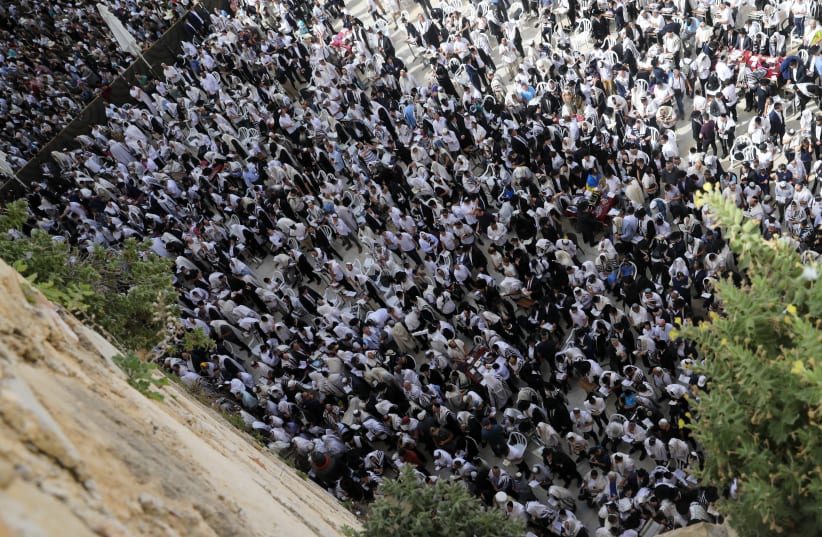It’s an innocuous press release of fewer than 250 words containing demographic figures that the Central Bureau of Statistics puts out every year around Holocaust Remembrance Day, which begins on Wednesday night.
Yet it is a powerful press release that can elicit tears as well as cheers.
With just a few demographic figures, it shows the cataclysmic changes the Jewish people have undergone over the last 83 years, since the eve of World War II in 1939, and also illustrates the transformative power of Zionism on the Jewish condition.
First, the figure that elicits tears.
Eighty-three years since the beginning of World War II and the Holocaust, the Jewish people have still not replenished themselves. According to the CBS figures, based on numbers from the Hebrew University of Jerusalem’s Avraham Harman Institute of Contemporary Jewry, the world Jewish population at the end of 2020 stood at 15.2 million. The definition of a Jew used in all countries, except for Israel, is anyone “who defines themselves as Jewish, or people who were born to Jewish parents who do not have a religious or ethnic self-definition.”

By contrast, the world Jewish population in 1939 stood at 16.6 million. Because of Hitler and Nazi Germany, there are still 1.4 million fewer Jews today than there were in 1939, a decrease of 9.2%. The world population, by contrast, has gone from 2.3 billion to 7.9 billion in that same period, an increase of nearly 250%.
Eighty-three years later and the world’s Jewish population has still not reached the level of what it was before the Holocaust. Encapsulated in that figure is the sheer enormity of the loss.
That’s the terribly sad news hidden in this release.
And the good news? The transformative news? The news that elicits cheers? That the Jewish population in Israel during this period went from 449,000 in 1939 to 6.9 million today.
That’s astonishing and something that has changed Jewish life and the Jewish condition beyond recognition. Had you told your great-grandparents or great-great-grandparents in 1939 that in 83 years the center of the Jewish world and Jewish life would be Jerusalem and Tel Aviv and not New York, Warsaw, Budapest or London, they would have scoffed and said you were crazy.
But there you have it.
While in 1939 only 3% of the world’s Jewish population resided in what is today Israel, which grew to 6% (650,000) on the eve of the establishment of the state in 1948, today that number stands at 45%.
And this despite the wars, the terrorism and threats of annihilation. This despite fears over the years that no one would want to come to a country under constant threat, or warnings that having to live constantly by the sword will chase away those already here. This despite a drumbeat of reports over the decades that the difficulty of life here will lead to massive yerida (emigration), that limited opportunities will lead to a “brain drain,” and that the high cost of living will force people to look for greener pastures and cast their lots elsewhere.
But rather than a shrinking Jewish population in Israel, what has shrunk is the Diaspora.
The ingathering of the exiles continues. Over the last two months, 15,000 Jews have moved here from Ukraine, Russia and Belarus. In 1939, according to that year’s American Jewish Year Book, there were 41 countries with Jewish populations of 25,000 or more; today that number stands at 17. If in 1939 there were 24 countries with Jewish communities of more than 70,000, today there are only 10.
The Diaspora is contracting, while the Jewish population in Israel is expanding; and that 45% of the Jewish population in Israel has built a strong, thriving, prosperous, vibrant and independent state that has changed the tone and tenor of Jewish life.
The early Zionists dreamed of creating a new type of Jew in Israel: self-reliant, strong, proud and unapologetic. They succeeded beyond their wildest imaginations.
If Israel has altered how the world sees the Jew – and it undoubtedly has – it has also altered the Jews’ image of themselves as well.
If Iran’s President Ebrahim Raisi thought that by saying, as he did last week, that Iran “will target the heart of the Zionist regime” if Israel “takes the slightest move against our nation,” would lead to quivering knees among the Jews, then he was living in a different century. Once upon a time, the bombastic threats of antisemitic autocrats would strike fear in the heart of the Jewish people. But no longer.
Why not? Because those Jews who have gathered in Israel since 1939 have developed the ability to fend off any such attempt. The world’s antisemites don’t frighten as much as they once did because the condition of the Jew – thanks to Israel – has changed fundamentally.
Current calls for Israel’s destruction as well as antisemitism that never dies show that some attitudes toward the Jews have not changed. What has changed, however, is the Jews themselves.
And that change is encapsulated in that figure in the CBS press release issued on the eve of Holocaust Remembrance Day: The Jewish population of Israel has grown from 449,000 to 6.9 million since the beginning of World War II. That figure – an increase of 1,437% – is astounding, and the major factor responsible for the radical transformation of the Jewish people and the Jewish condition since the Holocaust.
